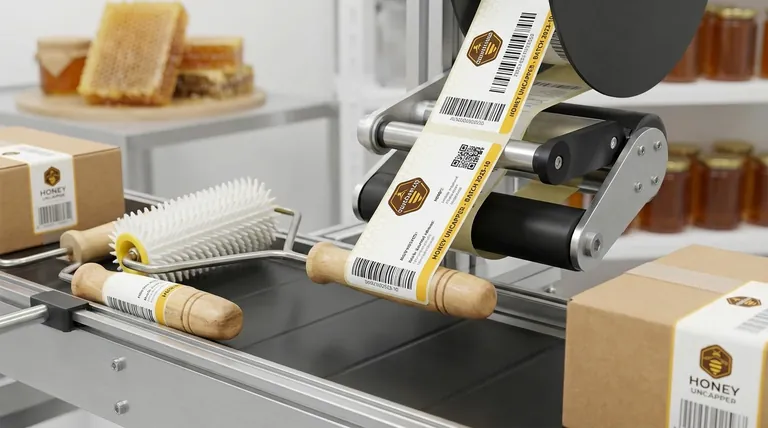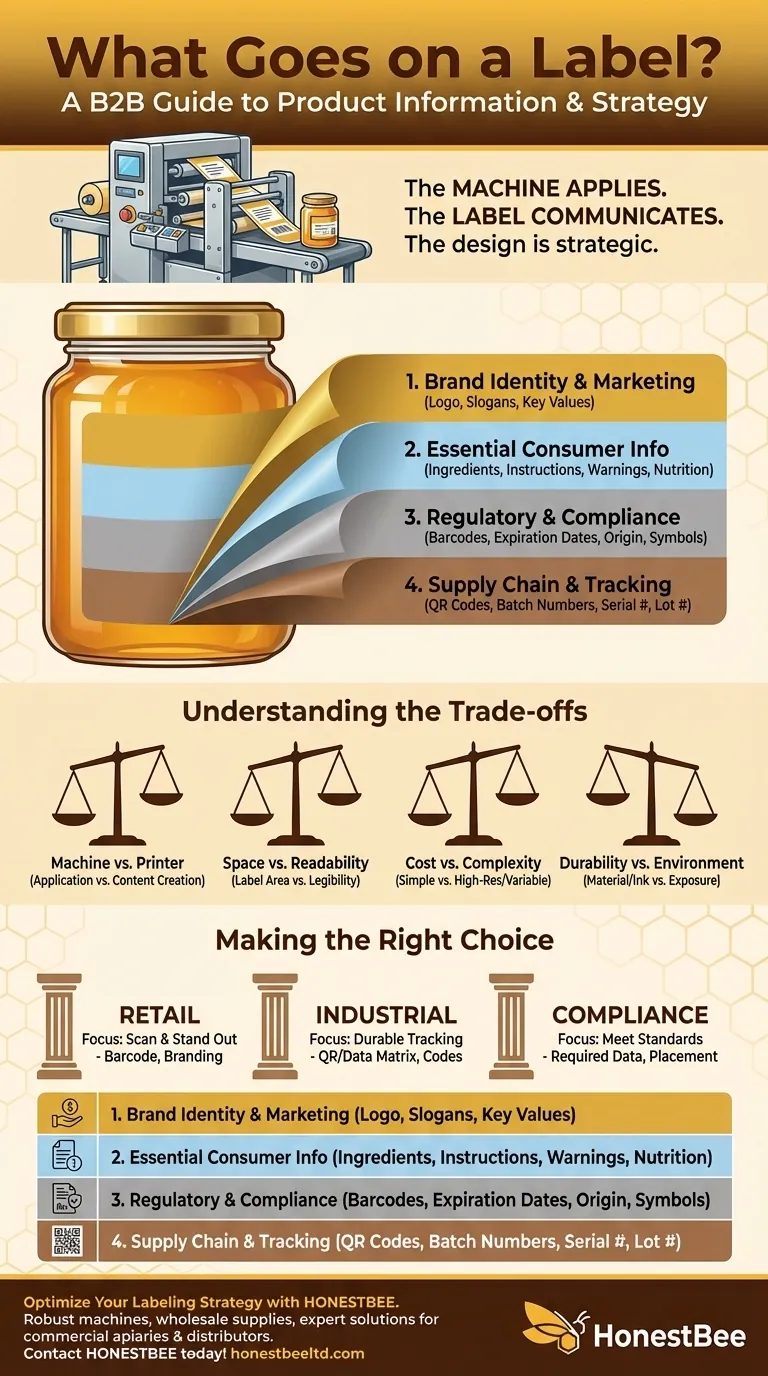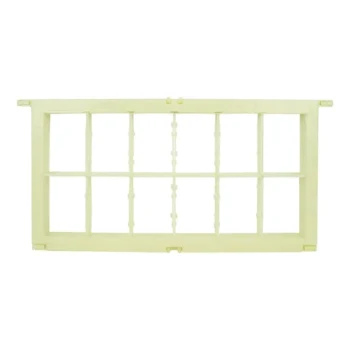In essence, almost any visual information can be included on labels applied by labeling machines. The primary limitation is not the application machinery itself, but the physical size of the label and the capabilities of the printing technology used to create it. Common examples include branding elements like logos, tracking data such as barcodes and QR codes, consumer information like ingredients or instructions, and regulatory requirements like expiration dates.
The labeling machine's role is to accurately apply a pre-printed label. Therefore, the question isn't what the machine can handle, but rather what information a label should strategically contain to serve its purpose for branding, compliance, and logistics.

The Functional Layers of a Product Label
A modern product label serves multiple functions simultaneously. We can think of the information as existing in distinct layers, each with a specific job.
Layer 1: Brand Identity and Marketing
This is the most visible layer, designed to attract the customer and build brand recognition. It establishes the product's identity on the shelf.
Information in this layer includes the product name, the company logo, brand colors, and any marketing slogans or key value propositions.
Layer 2: Essential Consumer Information
This layer focuses on informing and protecting the end-user. It provides the details necessary for safe and effective use of the product.
This includes usage instructions, ingredient lists, nutritional facts, and allergy warnings. Its clarity directly impacts consumer trust and safety.
Layer 3: Regulatory and Compliance Data
This information is often mandated by law or industry standards. Its primary purpose is to meet legal requirements for sale and distribution.
Key examples are UPC barcodes for retail scanning, net weight or volume declarations, country of origin, and specific warning symbols (e.g., flammable, poison).
Layer 4: Supply Chain and Tracking
This layer contains data crucial for internal and external logistics. It ensures a product can be tracked from production to the point of sale and beyond.
This includes lot numbers, batch codes, expiration dates, and serial numbers. Increasingly, QR codes are used to encode this data for easy scanning.
Understanding the Trade-offs
While you can print a vast amount of information, you are always working within constraints. Making the right compromises is key to an effective label.
The Machine vs. The Printer
It's critical to distinguish between the labeling machine and the label printer. The labeling machine simply applies the finished label to the product. The printer is what creates the content, and its resolution (DPI) and technology (e.g., thermal transfer, inkjet) will determine the clarity of small text and complex barcodes.
Physical Space and Readability
The most significant constraint is the label's surface area. You must balance the need for comprehensive information with the need for legibility. Overcrowding a label with tiny text makes it ineffective for both consumers and supply chain scanners.
Cost vs. Complexity
More complex labels with multiple colors, high-resolution graphics, or special variable data (like unique serial numbers on each label) increase printing costs. A simple, one-color label is far cheaper to produce than a full-color, photograph-quality one.
Durability and Environment
The information is only useful if it remains legible. The choice of label material and ink must match the product's expected environment. A product exposed to moisture, friction, or sunlight requires a more durable label and printing method than one that will sit in a climate-controlled warehouse.
Making the Right Choice for Your Goal
Your label's design should be dictated by its most important job.
- If your primary focus is retail sales: Prioritize a high-contrast, easily scannable barcode and clear, attractive branding to stand out on the shelf.
- If your primary focus is industrial tracking: Emphasize durable, machine-readable codes like QR or Data Matrix codes, along with clearly printed lot and serial numbers.
- If your primary focus is regulatory compliance (e.g., food or pharma): Ensure all required data, like nutritional panels, ingredient lists, and expiration dates, are prominent and meet legal size and placement standards.
Ultimately, a well-designed label is a strategic asset that communicates critical information clearly and efficiently to every stakeholder who handles your product.
Summary Table:
| Label Layer | Key Information | Primary Function |
|---|---|---|
| Brand Identity | Product Name, Logo, Slogans | Attract customers & build recognition |
| Consumer Info | Ingredients, Instructions, Warnings | Inform & protect the end-user |
| Regulatory/Compliance | Barcodes, Expiration Dates, Warnings | Meet legal & industry standards |
| Supply Chain/Tracking | Lot/Batch Codes, Serial Numbers, QR Codes | Enable logistics & traceability |
Optimize Your Product Labeling Strategy with HONESTBEE
For commercial apiaries and beekeeping equipment distributors, clear and durable labeling is non-negotiable. It ensures brand consistency, regulatory compliance for honey products, and efficient tracking of equipment batches.
HONESTBEE supplies the robust, high-performance labeling machines and wholesale beekeeping supplies you need to create and apply labels that withstand unique apiary environments. Let us help you enhance your operational efficiency and product presentation.
Contact HONESTBEE today to discuss your labeling needs and explore our wholesale solutions!
Visual Guide

Related Products
- Lightweight Plastic Uncapping Roller with Tines
- Semi-Automatic Pneumatic Bottle Capping Machine by HONESTBEE
- Automatic Honey Frame Uncapper Machine for Beekeeping
- Double Head Beekeeping Grafting Tools for Beekeepers
- Stainless Steel Pail Perch Bucket Bench
People Also Ask
- How does a honey bottle labeling machine improve work efficiency? Boost Speed, Accuracy & Profits
- How does a honey bottle labeling machine improve labeling accuracy? Achieve Perfect Brand Consistency
- What is the purpose of uncapping wax before using a honey extractor? Maximize Your Honey Yield
- How does a bottle capping machine work? Unlock Efficient, Consistent Sealing for Your Production Line
- How long does it take to learn beekeeping? Master the Beekeeping Learning Curve in 1-2 Years



















